Having recently returned from France, where I have been attached to a photographic section of H.M. Armies, it may be of general interest if I place on record a few particulars of the work of these sections, and the part played by electricity and engineering in carrying out their functions.
It must be clearly understood that these sections are not responsible for the actual taking of the photographs, as this duty falls on the Royal Air Force. The photographs cover quite a large range of subjects – such as front line and support trenches, panoramas of large tracts of country, large mosaics or photographic maps of certain parts of the country, “aerials" of particular spots, enemy gun emplacements, bridges and railways before and after bombardment, roads, etc.
The duty our little party had to perform was to tarn out copies of these photographs in large numbers and very quick working, when necessary, night and day, to get the work turned out in time to be of service for the particular military operations they were required for – whether it was for operations on a large scale or for local raids or artillery work. To give some idea of the magnitude of the operations these small isolated and almost unknown "sections" of the Army carried out, I may say that work equal to 23,000 full-plate photographs was turned out in 36 hours for one of the big blows dealt at the enemy last August Having gone so far to show the extent of the work, we now some to the means of carrying it out, and this is where electricity and engineering played their part "in the game."
As these photographic sections have to move with the armies, the apparatus is often being. dismantled, moved, and re-erected, and as the conditions vary with every more, retreating or advancing, the plant is put to work under a variety of conditions; sometimes the generating plant is resting on a few piles driven in the ground, and at other tunes on a good solid concrete foundation.
The plant I was in touch with consisted of one Gardner 5-H.P. petrol engine, direct-coupled to a 3-kw. Holmes generator running at 500 R.P.M. These machines were, of course, mounted on one bedplate. A second set consisted of a Petter Junior petrol engine, direct-coupled to a 3-kw. Holmes dynamo running at 725 R.P.M., on a common bed-plate.
The working voltage in the depot was 110, and as a steady light was very essential for the photographic work on account of the time for exposure, for printing, equalizing, etc., the supply to the depot was always taken from accumulators, of which we had two complete batteries, which were need alternately, one being charged whilst the other set was being uncharged to the works.
These batteries were generally accommodated in a room or hut near the engine-room, and complete control of the whole installation was obtained by a switchboard in the engine-room, fitted with the usual meters, charge and discharge switches, change-over switches for switching in or out either generator on to either battery, and also for switching either battery on to the works.
All outgoing circuits were controlled by switches and fuses on the main switchboard, and mercury vapour lamps, general lighting and night-light circuits, etc., were all separate.
The batteries were put p in teak boxes, lead-lined, and fitted with lids, and each set had a capacity of 190 ampere-hours. These had a fair amount of rough usage during the various hurried removals, but kept up to their work very well.
As photographic prints of each subject were sent to our works, and not the original negatives, it was necessary to make a fresh negative from each print sent in, and this often meant over 100 subjects per day. These were taken with the aid of Cooper Hewitt mercury vapour lamps, two tubes in series in one frame, and two complete sets being used. In the case of photographs requiring to be enlarged, a Westminster arc lamp and enlarging camera were utilised. All printing from negatives was done in special printing boxes, lighted either by half-watt or ordinary M.F. lamps, and the same remark applies to the equalizing boxes.
 Gardner Petrol Engine.
Gardner Petrol Engine. After being printed, developed, fixed, and washed, all prints were hung up in a drying-room heated by slow-combustion stoves and spirit flares, and the air was kept moving with two 12 in. electric fans. As the temperature in this room was generally about 120 degs., the prints were dry and ready for the cutters in a very few minutes.
The water supply was generally obtained from a stream near which the works were always situated, and the water pumped up to a supply tank with a Pelapone pumping set consisting of a petrol engine driving a turbine pump by means of a V-shaped belt, the set being mounted on a wooden frame, and so arranged that when the pipes were disconnected, it could be picked up bodily and carried. The water supply tank was generally fixed on a wooden structure near the main shed or building, and the water supply to all the washing sinks was run in screwed iron pipes, although a quantity of hose pipe was used for connecting up to the pump and tank at various times. The quantity of water used would be about 2,000 gallons per day.
Floats and indicators were used in and connected to the supply tank, and arranged with electrical contact, either to ring a bell or switch on a coloured light when the tank was either full or empty.
The general lighting of the depot, which consisted of dark rooms, cutting-room, stores, office, engine, battery and pump rooms dining room, billets, etc., was carried out with ordinary M.F. lamps, and the general wiring was carried out on the cleat system, this enabling dismantling and re-erecting to be carried out in a very short time; I have known the plant to be dismantled and taken across country thirty or forty miles, photographic work being resumed in something like 48 hours. This, of course, was with a good deal of very temporary work, but the "military machine" had to be kept going, and the work of making a fairly decent job of the general installation had to be done whilst the place was kept working; very often, as soon as it was a, bit straight, another move would be ordered. However, as the production of these photographs in an efficient and quick manner very often meant the saving of thousands of valuable British lives and the destruction of those of the enemy, everybody worked with a will for a definite purpose.
Pelapone pumping set.
The engineering staff consisted of another R.E. and myself, and the total works staff only amounted to 25, including officer, N.C.O.'s, engineers, dispatch rider, cook, storekeeper, and photographers.
The illustrations show some of the plant as used and described, and I might also add that the switch used for the firing of the mines at Messines Ridge eventually found its way on to our switchboard.
Such is a short account of one of the many cases where engineering and electricity, in particular, have come to the aid of our Armies, and have been used to advantage in helping to beat the Hun and save civilisation from a fate that was too horrible to contemplate.
H. Moss.



Tidak ada komentar:
Posting Komentar